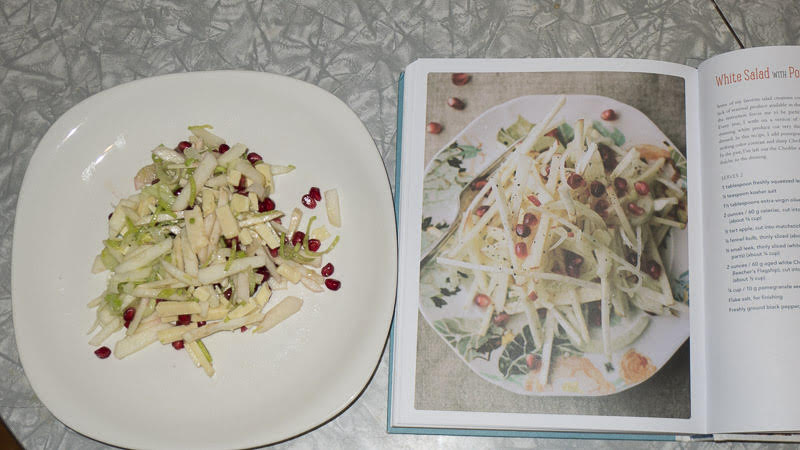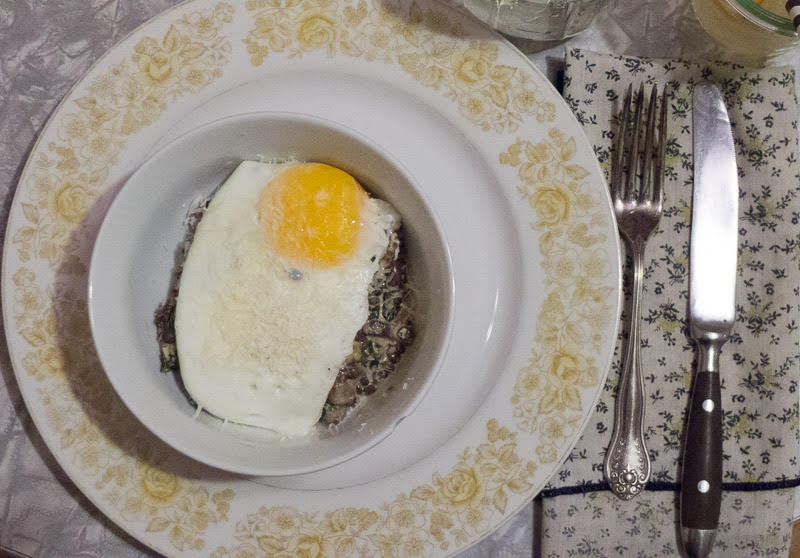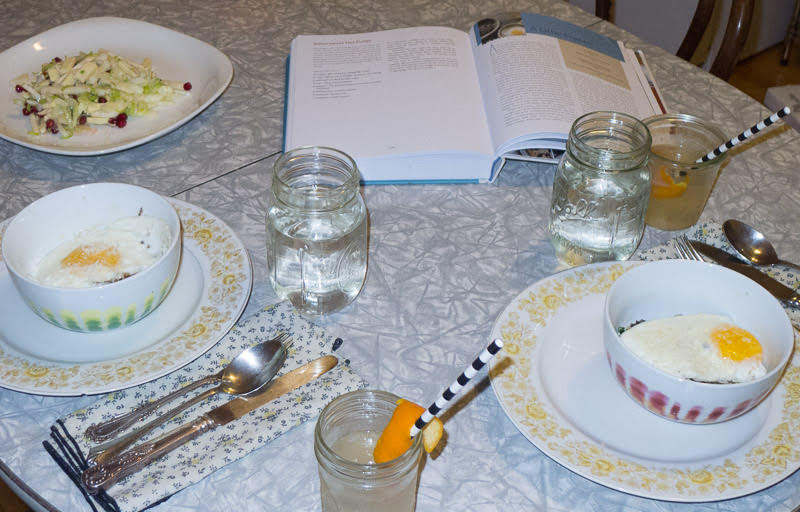Cooking with Class: A Little French
One of the most significant pulls of a cookbook like Date Night In is personal narrative. Ashley Rodriguez, the author, is allowing us to travel through time by sharing her story along with recipes and ideas for meals. She has us come with her as she recounts places she’s traveled, and much of the book relies on her own life and place. She is nostalgic for meals of memories past while remaking them in the present and for the future. Current food trends place importance on the past, utilizing old-fashioned hand methods of fermentation and preservation (Date Night In does this with créme fraîche). Menus highlight the travel narratives of a global culinary education, pulling from Italian, French, and Greek cuisines, while also emphasizing fresh and local ingredients. However, to privilege these ideals is a privilege unto itself. Keeping things simple is easy when you have the time and equipment to do so.
This comes into play as I am deciding which menu to choose this time around. I have to nix a few menus in the Winter chapter that called for equipment and/or skills I don’t have. For example: “A Flemish Feast” required me to deep fry potatoes for Belgian frites—Rodriguez’s method actually has you fry them twice at two different temperatures. Lacking a kitchen thermometer and armed with a healthy fear of grease fires and clogged arteries, I can’t bring myself to do it. Looking on to dessert, I realize I have no way to make the Yeasted Belgian Waffles, either. Rodriguez has you cook the waffles “using your favorite waffle iron.”[1] Seeing as how I don’t have a waffle iron, much less a favorite one, I realize it might be better to move on and choose something else.
Finally, I hand the book over to my boyfriend and say “choose one from the Winter section. Just not the Belgian one.” Sensing my stress levels, or just being a good and healthy eater, he chooses the menu entitled “A Little French.” This is the simplest menu in the section. It reads:
- Grapefruit 75
- White Salad with Pomegranate
- Braised French Green Lentils with Mushrooms and Kale
- Café au Lait Pudding and Cocoa Nib Florentines
Lentils?! Not only are they cheap and easily procured in the bulk section, I’m also excited at the prospect of not having to do things like ferment cream or measure the temperature of frying oil. The introduction to this menu praises the simplicity of the dishes to be served and that calms my nerves.
The timeline is relatively easy, though it does suggest making the desserts three days in advance. Having decided on the menu a mere day and a half beforehand, I already feel behind. I decide to immediately start on the dessert. The Cocoa Nib Florentines seem easy enough but call for cocoa nibs. When I see a carton of something I think are the nibs, I’m terribly confused. They are labeled “Cacao Nibs.” Is that the same thing? Having been to three stores already, I’m ready to give up so I swallow my worry that they are not only the wrong item but also $7, and throw them in the cart. The grocery list also calls for an entire pint of heavy whipping cream. I don’t know if I should be amused or scared.
Once my daughter is asleep that evening, I get to work. I make the Florentine cookies, then I make the Café au Lait Pudding while the cookies bake. Everything is going smoothly until I drop the box of cornstarch into the bowl and have no idea how much goes in. Having never made pudding before, I figure it’ll work itself out and just whisk it really vigorously. The cookies turn out well except butter seems to be seeping out of them. I give my boyfriend one to try and he goes for another asking where I’ve put the “butter treats.” I worry we will have none left by tomorrow and the fact that he’s making me feel like Paula Deen.
Everything else on the menu appears straightforward. I pre-cook the lentils as Rodriguez suggests (I’m really beginning to love this timeline approach) and try to stay abreast of the situation by chopping and prepping as much as possible. I de-seed the pomegranate called for in the salad, make the vinaigrette, and feeling confident, decide I can probably just make the whole salad while my daughter plays in the kitchen. I look over the recipe and her description of the ingredients another time. She writes that the inspiration for this salad is the “lack of seasonal produce available in the winter” and continues by noting the “stunning white produce [should] be cut very thinly.”[2] I scan down the ingredients, gather them together and read on. She instructs the reader that the celeriac and apple be cut into matchsticks. While my daughter begins to whine and grab at my legs, I attempt this but then read: “I use a mandoline to make easy work of cutting the apple and celeriac into matchsticks.” I fly into a rage as I question whether I should make myself the cocktail now. I really should look into getting a mandoline.

Photo by the author for Dilettante Army
I do my best to attack the stubborn celeriac with my dull kitchen knife. More like jumbo crayons than matchsticks, I figure “good enough” and get on with it, throw everything in a bowl and chuck it in the fridge for later. I move onto the lentils, which goes uneventfully, although I hesitate as I pour a cup of heavy whipping cream over them. I don’t regret this later, however.

Photo by the author for Dilettante Army
After we sit down to eat, we both agree everything is delicious although I have a hard time chewing the celeriac. I didn’t slice it thin enough. But everything goes down quickly and deliciously until we get to the pudding. My cornstarch mistake proves a huge misstep. My boyfriend, bless his heart, loves it and devours (or chokes down?) the whole thing. I find it so disconcertingly lumpy, I stop midway through. It could’ve also been the realization that we’ve probably consumed almost a full pint of cream and half a stick of butter. While I feel guilty about this, I also begin to realize how rich all these meals seem to be. I understand that these are for “date nights,” special nights where one can indulge, but at the same time, Rodriguez writes that these are weekly affairs in her home. And so I wonder at the privilege but also the actual ingredients that are used.
Most of the recipes in the book are butter- and cream-laden dishes that are, of course, absolutely decadent and delightful but also reveal something about where we place importance culturally. Grass-fed dairy, free-range eggs, and raw milk are having a heyday as many consumers become aware of the importance of buying local and farm-fresh items. Rodriguez writes about the “stunning white produce” she sources locally—it’s a fun challenge for her to find local and seasonal vegetables in winter.

Photo by the author for Dilettante Army
While we imagine transparency in our food chain, we disregard the clear lines of privilege that run alongside. Writer Sara Davis, reviewing Roland Barthes’ essay “Ornamental Cookery,” posits that food of this nature, photographed and manipulated to great extent, is a tool to disguise the hidden costs of the labor and production. In addition, food attains fantasy status as a commodity on social media sites such as Instagram and Pinterest. Davis explains that the “ornamentation itself plays into the impression of magical or fairy tale dishes.”
Rodriguez’s all-white salad is a triumph of visual ornamentation and local sourcing. The salad is tightly curated by our demands for perfection in both the product and its origins, from the single ingredient ($7 fair-trade cacao) to the final product, photographed for social media and publication.
Ornamentation and the marketing of full supply-chain has hit new heights. In December of 2015, Mast Brothers Chocolate was accused of melting commercial chocolate to produce their hyper-artisanal and beautifully packaged chocolate bars. Their website explains that they produce chocolate “with an obsessive attention to detail, meticulous craftsmanship, groundbreaking innovation and inspirational simplicity.”
In a four-part series, DallasFood.org revealed that Mast Brothers had used commercial chocolate in bars they sold in 2009. However, the Mast brothers have continually asserted that they never lied about using commercial chocolate in the initial phases of production. So perhaps this scandal is not necessarily about the chocolate but the way we convince ourselves of transparency.
The Mast brothers sell their chocolate on the same lifestyle values as Date Night In: seasonal, local produce and keeping things “simple.” Dana Goodyear writes about the chocolatiers’ principles:
At a moment when making things from scratch was elevated to the highest art, and “bean to bar” chocolate became associated with localism, meticulousness, and integrity, the brothers reigned.
The Mast brothers sold chocolate bars with flavor combinations such as “Italian sheep’s milk” or “olive oil” and wrapped in beautiful paper (Marc Jacobs is designing a limited edition 2016 Valentine’s bar).[3] Claims of handmade, high-quality ingredients paired with impeccably sourced milk or olive oil appeals to a style of contemporary consumption that desires transparency. This is, perhaps, why the revelation of Mast Brothers’ use of commercial chocolate was so shocking.
The emphasis we place on locality, seasonality, and fair trade is similar to the way that convenience and mechanized artificiality were important to those the Atomic Age. In comparison to domesticity in the 1950s, our current generation privileges the handmade, the hyper-local. At the time Barthes wrote about the ornamentation of cookery and its relation to socioeconomic class, gelatin molds and thick, creamy sauces were cropping up. This was the age of Betty Crocker and boxed foods. As food writer Tamar Adler explains,
“Behind the Betty Crocker recipe box lurks the Cold War…these glossy cards were another theater for the standoff between socialism and capitalism….Surely the lush profusions on each card stand in diametric opposition to the Soviet aesthetic of the day, with its homemade loaves of dark bread, its communes and caps and kvass.”
Today’s culinary luminaries turn their noses at processed foods, preferring those homemade loaves of dark bread and housemade kvass that the Atomic Age was running from. As we fall in love with nostalgic packaging and “bean-to-bar” products, we are consuming a story rather than the food itself.
Helen Rosner theorizes that the Mast Brothers story became a scandal because of our relationship to capitalism. Is it possible all our social fears and anxieties, as seen through food culture, comes back around to this?
The story of Mast Brothers’ success is essentially a story of packaging.
Given everything, really, what our delight at their downfall truly reveals, more than anything, is how we as a consumer culture lie to ourselves about being consumers of culture….Branding and authenticity together make up the cornerstones of consumption and identity performance. We make choices of what to buy and what to display, and through those choices we construct (or, oh fondest hope, reflect) our identities and affiliations. Price—and the perception of value—is an essential part of that.
Betty Crocker gave us a fantasy of modernism, recipes to cook up dreams suspended in new food products like gelatin while society hurled itself forward into futurism and the Space Age. In the same way, our current food culture throws us back, privileging the past, waxing nostalgic for the days of purity and authenticity, of farm butter and fermented cream. As the Atomic Age era relied on artifice and manipulation to represent and suspend its worries, we rely on rusticity as a way to simplify and slow down.
But there is deception within this simplicity, because the food we eat and the dishes and culture we create around them “express the eternal paradox that it is impossible to draw a clean line between the artificial and the natural — because interceding upon nature through elaborate artifice is a deep, old, natural human behavior.” As Dana Goodyear writes, “going backward is charming only to the exceptionally privileged—those who have tired of modernity and would like to try something else for fun.”
[1]Rodriguez, Ashley. Date Night In: More than 120 Recipes to Nourish Your Relationship. Philadelphia: Running Press Book Publishers, 2014. p. 257.
[2] ibid. 263
[3] Marc Jacobs collaboration from Mast Brothers Instagram page accessed February 3, 2016.



Dilettante Mail
Get updates from us a few times a year.